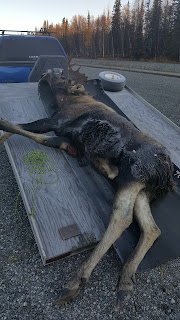The future of wild salmon depends on the decisions Alaskans make today
By: Steve Harrison
 |
| This rowdy crew is know to "take care of business" on fishing days. |
Our state is home to the world’s last stronghold of wild salmon and, for the most part, we have managed our fisheries well. For generations Alaskans have sustainably harvested millions of wild salmon while this amazing fish continues to return to their native streams, spawn and rejuvenate the population every year.
Tasked with developing policies that protect our salmon resource, the Alaska Board of Fisheries uses the basic principles of sustainable yield and conservative management to drive decision making and, by and large, it has worked.
But managing the harvest of salmon is only part of the equation. Ensuring our salmon runs remain strong also means protecting the habitat they depend on, from the wetlands at the headwaters of the streams where they spawn, all the way to the ocean where they spend the majority of their lives.
In recent years, pressure to allow mining and damming interests to set up shop in and around our prolific salmon streams has increased greatly, with proposed projects like the Pebble Mine, Susitna dam, and the Chuitna Coal strip mine leading the charge.
One by one, developments much smaller than these have destroyed salmon runs in the Pacific Northwest. Attempts to replace the runs with hatchery fish have proven expensive and largely ineffective. It has been estimated that salmon runs of the Pacific Northwest are dwindling to roughly 6-7% of their historical levels. There is no question - poorly planned dams and mines kill salmon.
If we sit back and do nothing in Alaska, then the outcome is clear: We are next in line to lose our salmon.
I have been a Northern District setnet fisherman in Upper Cook Inlet for 36 years and, like hundreds of thousands of other Alaskans, have a vested interest in the sustainability of wild salmon. As setnetters we are held to a detailed set of rules and regulations. The Cook Inlet Area Commercial Fishing Regulations published by the Alaska Department of Fish and Game is a binding document for commercial salmon fishermen. It is 113 pages long. In it can be found detailed information about where, when, and how fish can and cannot be caught, sold, and processed.
Unfortunately big development proposals aren’t held to such specifics. Alaska’s Title 16 – which deals with all things fish and game – contains the guiding statements for development in sensitive salmon habitat. It says:
By law, an activity that will use, divert, obstruct, or change the flow or bed of a specified river, lake, or stream requires a Fish Habitat Permit. The Commissioner of the department of Fish and Game is directed to issue the permit unless the plans for the proposed construction work are “insufficient for the proper protection of fish and game.”
That’s it. That’s State law concerning the protection of our salmon from large-scale development projects. 113 pages of rules for set netters, two sentences for Pebble.
The problem is, nothing in Title 16 or Alaska Department of Fish and Game regulation defines what is sufficient for the “proper protection of fish and game,” and no review criteria exists to ensure that permitting decisions will protect salmon and the habitat they depend on.
The good news is that such a document already exists and has been adopted by the Board of Fisheries. It is called the Sustainable Salmon Policy, and is a comprehensive, thorough and thoughtful document that outlines clear standards for protecting Alaska’s salmon habitat. Unfortunately this common-sense solution has never been officially adopted into law.
Recognizing this, I joined with eleven other concerned Alaskans representing commercial, sport, subsistence and personal use fishermen, as well as experts in the field of fishery management, to author a Board of Fisheries proposal that attempts to fix this problem in Title 16 by addressing fish habitat permitting. Our proposal is simple and straightforward: We are asking the Board of Fisheries to recommend that the Legislature amend Title 16 by adding elements of the Sustainable Salmon Policy.
On Oct. 18-20, the Board of Fisheries will have the opportunity to take action on this proposal at a workshop held in Soldotna. Moving this proposal forward is the first step in ensuring the wild salmon runs that are iconic to our state and so many of us rely on remain strong today and into the future.
###
Steve Harrison is a commercial fisherman from Talkeetna and one of eleven authors of the Sustainable Salmon Proposal currently being considered by the Alaska Board of Fish.


